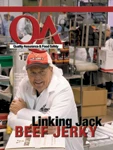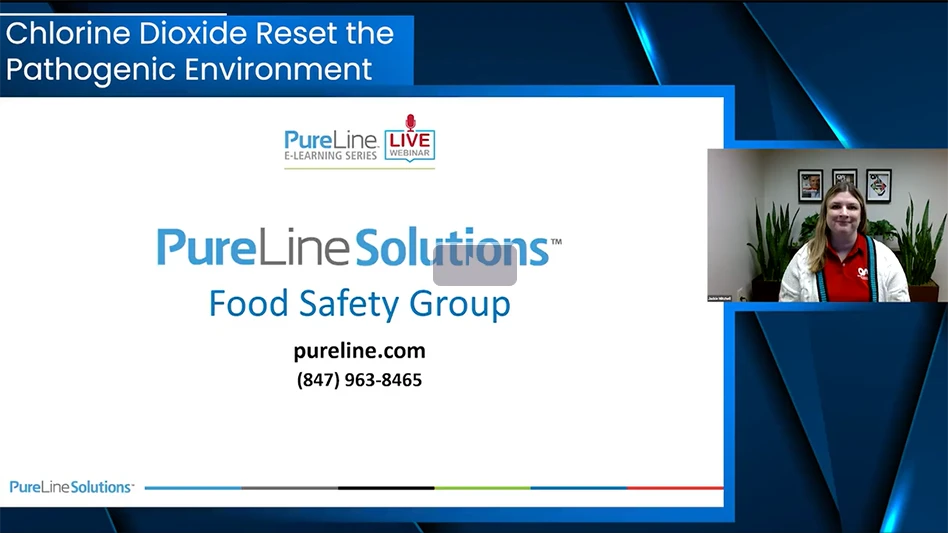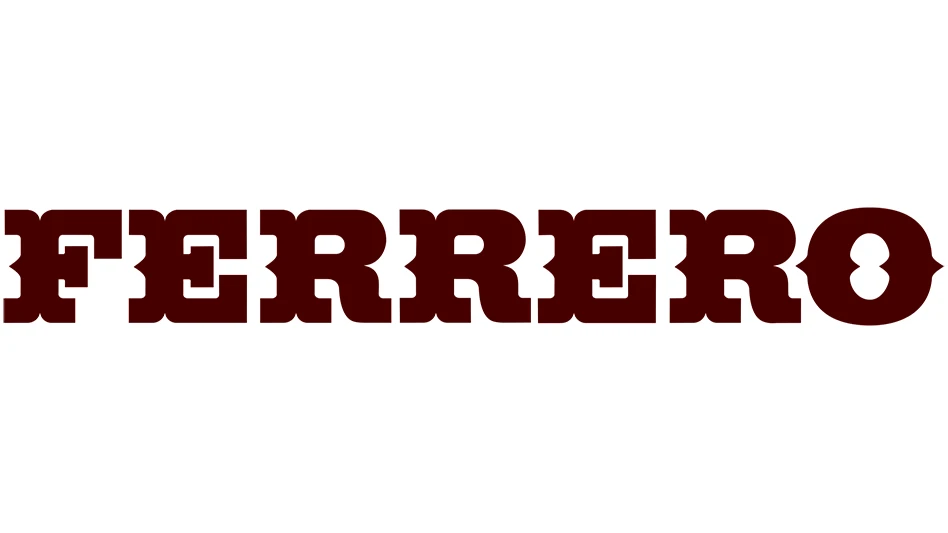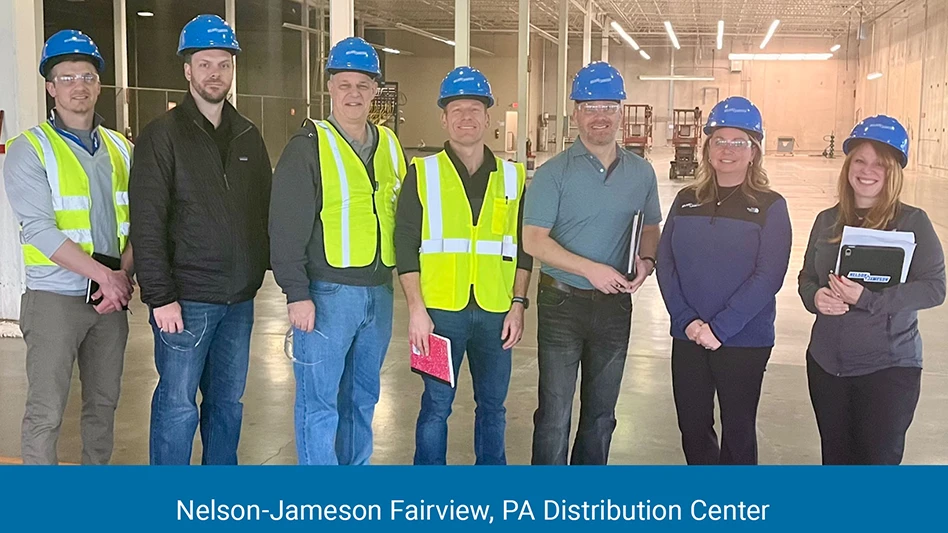Condensation which drips onto a food-contact surface, equipment screwheads against which food products flow, a bolt on the inside of machinery. All can cause adulteration in your food product through the introduction of pathogenic bacteria, allergens or metal fragments, but some practical applications of sanitary design can decrease and even prevent the potential of such contamination.
How do you determine if the equipment in your plant or that you plan to purchase meets sanitary design qualifications? What can you do in your facility to increase its sanitary design? And … how much will it all cost you?
With the impetus toward establishing sanitary design in food plants increasing across industry sectors, publications and education on integrating sanitation into your equipment and facility design are prevalent. For example, the American Meat Institute (AMI) formed an Equipment Design Task Force to develop operational and equipment design guidelines to minimize the spread of Listeria monocytogenes; the International Fresh-cut Produce Association (IFPA) published a Sanitary Design Buying Guide and Checklist; USDA developed Guidelines for the Sanitary Design and Fabrication of Dairy Processing Equipment; and numerous workshops, seminars and full conventions have focused on sanitary design.
We spoke with representatives from various sectors, associations and specialties to discuss the evolution of sanitary design, compile key strategies, and expand on the reality of the economics.
EQUIPMENT DESIGN. In 2002, AMI’s Equipment Design Task Force (EDTF), comprised of 10 processing companies, developed 10 Principles of Sanitary Design, along with a checklist tool by which manufacturers and processors can check their equipment against the principles, and a facility design principles guide and checklist. (See Sanitary Design Resources, page 58.) In chartering the task force the AMI Board of Directors agreed to make food safety a non-competitive issue, which allowed all participants to fully disclose all knowledge of the issues being discussed, says Skip Seward, vice president of regulatory affairs for AMI. Such proactive actions were recently recognized by the American Society of Association Executives when AMI was named to its 2006 Advance America Honor Roll for its sanitary design principles for facilities and its overall food safety efforts.
Although created for the meat and poultry industries, the equipment principles and checklist are valuable for all plants desiring to implement sanitary design. "Customers have used those principles to do in-house evaluations of existing ready-to-eat processing equipment to find where gaps exist," Seward says. "The principles have allowed a mutual focus of discussion for customers who are producing product and those who are manufacturing equipment," he adds, explaining that the principles thus serve as an element of common-ground discussion when a plant is purchasing new equipment.
AMI’s 10 principles of sanitary design for equipment are:
1. Cleanable to a microbiological level: Constructed to ensure effective and efficient cleaning throughout its lifespan, and to prevent bacterial ingress, survival, growth and reproduction on both contact and non-contact surfaces.
2. Made of compatible materials: Construction materials completely compatible with the product, environment and cleaning and sanitizing chemicals and methods.
3. Accessible for inspection, maintenance, cleaning and sanitation: All parts readily accessible for inspection, maintenance, cleaning and sanitation without the use of tools.
4. No product or liquid collection: Self-draining to keep liquid from accumulating, pooling or condensing on it.
5. Hermetic sealing of hollow areas: Hollow areas (e.g., frames, rollers) eliminated or permanently sealed. Bolts, studs, mounting plates, brackets, junction boxes, nameplates, end caps, sleeves, etc., continuously welded to the surface, not attached via drilled and tapped holes.
6. No niches: All parts free of niches (e.g., pits, cracks, corrosion, recesses, open seams, gaps, lap seams, protruding ledges, inside threads, bolt rivets, dead ends).
7. Sanitary operational performance: Performance during normal operations not contributing to unsanitary conditions or the harborage and growth of bacteria.
8. Hygienic design of maintenance enclosures: Maintenance enclosures and human machine interfaces (push buttons, valve handles, switches, touch screens) designed to ensure food product, water or product liquid does not penetrate or accumulate in or on the enclosure or interface; physical design of enclosures sloped or pitched to avoid use as storage area.
9. Hygienic compatibility with other plant systems: Hygienic compatibility with other equipment and systems (e.g., electrical, hydraulics, steam, air, water).
10.Cleaning and sanitizing protocol validation: Cleaning and sanitation procedures clearly written, designed and proven effective and efficient; recommended cleaning/sanitation chemicals compatible with equipment and manufacturing environment.
Integrating sanitary design with your sanitation program enables you to "engineer out the problem," says Jonathan DeVries, senior technical manager for Medallion Labs/General Mills in Minneapolis, Minn., citing screw headers, vibrators, cross conveyors, and hopper carts as key sources of cross contamination in plants. Some strategies DeVries recommends for integrating sanitary design into equipment are:
Re-engineer existing systems according to sanitary design principles.
Design in access for cleanout and inspection.
Isolate allergen addition points in equipment.
Dedicate recoup/refeed systems.
Eliminate cross over and poor product containment points.
Dedicate production systems and/or install parallel modules for units which are not cleanable.
Look for …
When purchasing new equipment or reworking existing machines, plants should also look for and ask about sanitary design in:
Accessibility – The more open the design of a machine, the more efficient workers can be with inspection, maintenance, and thorough cleaning. "If it’s easier, it’s more likely to get done," Seward says.
Niches – Screws and other connection points should not be recessed, says Don Graham, president of Graham Sanitary Design Consulting, Ltd., in Jackson, Mich. "It just makes a place for stuff to collect," and is not an area which workers generally think to clean.
Cleanability – Does the machine need to be completely disassembled for cleaning, or has this been simplified through its design? Are any internal parts potential collection points but hidden from view or reach? Can the equipment be easily cleaned by one or few people, or is an entire team needed?
Metal fragments – "You’re always finding machine parts in product," Graham says. One way to avoid this is to ensure that bolts are oriented so the bolt head is on the inside of the equipment and the nut holding it in place is on the outside. This way, if the connection happens to works its way loose, the nut won’t fall into the product. Rather it would fall out onto the floor, where someone is more likely to see it and be able to fix the problem before a part (i.e., the loose bolt) falls into the product. In addition, any nuts used should be cap nuts so that no threads are showing.
Metal-to-metal contact should also be avoided; not only does it have the potential of creating metal fragments, Graham says, "it also provides a hidden area with a high potential of microbial growth and is almost impossible to clean."
Spare parts – Does the equipment have a lot of spare/small parts to be removed for cleaning and/or potentially fall into product? Are all spare parts set flush with their surrounds and tightly fitted, or do they create niches for collection of bacteria, allergens, and foodstuffs?
Surfaces – All surfaces, particularly those which have food contact, should be treated to reduce niches, be scratch resistant and meet regulatory guidelines as non-reactive, non-corrosive, non-contaminating and non-absorbent.
FACILITY DESIGN. Designing your facility for efficiency in sanitation is often simpler than plant managers may realize. "A lot of it is common sense; things that people don’t realize," Graham says. "Sanitary design and sanitation are partners." And it’s a point which holds true for both bacterial contamination and allergenic cross contamination. "If you do proper sanitation, then you have gone a long way in controlling allergen contamination."
Look for …
When assessing your plant environment for sanitary design, consider:
Lighting – "If people can’t see the dirt, they’re not going to clean it up," Graham says.
Airflow – Airflow should always be positive from processing areas to non-processing, from non-allergenic processing to allergenic, and from the inside of the building out, so that contaminated air is not being brought into the plant with deliveries, personnel, etc. "If you don’t control the air in your plant, you have no way of knowing what’s in the air," Graham says. Control can be achieved with the installation of an air-handling system, but plants must be sure to also stay up on the maintenance of the system. In addition, he adds, "air handlers to accomplish that correctly are relatively expensive." Because of this, smaller plants often try to achieve a similar effect with fans which pull air outward. Air curtains on doors, complete truck-to-door seals in delivery areas, and ventilating dual-door entry areas also can help keep external air external.
Condensation – Proper ventilation also can help to decrease condensation, which is a significant contributor to contamination. "Condensation has been determined to be a great growth place for bacteria, because all bacteria need is a drop of water," Graham says. Thus equipment should be designed for run-off and floors sloped toward adequate drainage. If a pipe or line with the potential to build up condensation runs above another product line, it should be regularly inspected, cleaned, wrapped, or otherwise air-dried or shielded. "If condensation can form and fall onto food product, food in processing or a food-contact surface, then the surface from which that condensation came must be treated as a food-contact surface," Graham says.
Flooring – "The floor is the most abused surface in the food-processing plant," Graham says. "The most stress you can imagine happens to a floor." It is regularly subjected to chemical stress, lubricants, cleaning and sanitation chemicals, temperature extremes, moisture and mechanical stress (such as forklift traffic, dropped tools, dragged pallets). Even with concrete flooring, the repeated stresses and moisture can eat through the top layer to the aggregate, with the pitted area then becoming "hiding places for bacteria," he says. When selecting materials and/or sealants for plant flooring, managers should keep these stresses in mind and question manufacturers on their warranties for the material’s ability withstand such pressures. (See item four in Sanitary Design Resources, page 58, for more information.)
Cleaning – Even cleaning can backfire on a plant’s sanitation efforts. "The recommendation today is to get rid of the high-pressure hose," Graham says. Because high pressure creates aerosols which can remain in the air for four to six hours, bacteria or allergens that were spray-washed off floors and equipment can hang in the air to fall back onto foods or food-contact surfaces. "Instead, back off the pressure and use more water," Graham advises. "Use low pressure with more volume."
Packaging areas – "Here you run into a dichotomy," he says. "Some plants have separate packaging rooms, others don’t." Yet it is a key area for air pressure, airflow control. "Where the product is last in touch with the environment, you should have the higher filtered air pressure."
THE ECONOMICS. Graham says he has been preaching sanitary design since the 1990s. And today, he adds, "The stress on sanitation is at the highest point it has been in history."
For the most part, equipment manufacturers have now gotten on board, he says, "but it was a long uphill fight." Manufacturers had felt that their customers would not pay the extra costs for the new design, but there is now enough evidence that machines can and do cause contamination that plants are requesting equipment to meet sanitary design standards. In addition, Graham says, manufacturers are beginning to consult with him on what is necessary for increased sanitary design. "They’re finding out that there’s a market out there, and asking how they can better design their equipment so it is cleanable."
All this serves to help bring down the costs of such equipment. "They will become more economical as they get more use," Graham says. Because it’s the design of a new piece that adds the most expense to a manufacturer, as production increases and sanitary design becomes more accepted, the equipment becomes the standard and the pricing follows. In addition, although it may seem costly to purchase equipment designed for sanitation, rework equipment in the plant, and incorporate sanitary design principles into your plant environment these actually reduce costs in the long run, Graham says. The labor efficiencies gained on the back end, as well as the decreased potential for contamination and recall, provide value well above the added costs.
Jim Whitehead, general manager of Superior Contract Cleaners, West Berlin, N.J. is also sees a change in the design of equipment toward cleanability as well a value of economies, which is good for the plant and the consumer. In the past, equipment was often difficult or even impossible to clean, requiring complete disassembly or not providing a balance between production needs and cleanability needs. "Now we try to work with [plants] and equipment manufacturers in the hope that we can come up with a way to solve all the issues with one design," Whitehead says. "If through equipment design we can clean with one person instead of more, it will save production dollars and ultimately consumer dollars."
As a result of all the industry focus, manufacturers are placing more emphasis on sanitary design in the development of new equipment, and as the equipment moves from the realms of custom order to standard issue, the costs are declining. "The leading manufacturers of ready-to-eat processing equipment have embraced the use of the sanitary design principles," Seward says.
In addition to the focus spreading across the nation’s food processing industry, Seward is seeing sanitary design move beyond facilities and equipment and beyond the borders of the U.S. "There’s been interest on other fronts," he says, citing one example of the development of easy-to-clean chain-metal mesh gloves and garments. "They’ve used the principle to help improve the design of personal protection equipment." In addition, Seward has seen interest by the European Union in the sanitary design principles, and is noting increased publication of articles in European journals and trade magazines, he says. This is due, in part, to the fact that many manufacturers make and/or sell equipment internationally and to various industry sectors, so the equipment being manufactured with sanitary design in mind is being spread around the industry and the globe.
But one of the things that Seward sees as most validating for the principles the task force developed, is that, though they were created in 2003, they are still being implemented as developed. "They have stood the test of time; they have not had to be changed," he says. "The task force did an excellent job." QA
-------------------------------------------------
Sanitary Equipment Design and Facility Design Checklists, American Meat Institute (AMI). Along with the development of sanitary design principles, the AMI task force created checklists for conducting reviews of plant equipment and facility environment as to how well they are designed for sanitation and where improvements can be made. The checklists also are beneficial for use as assessment in the purchase of new equipment. The AMI fact sheets are available online at www.meatami.com, Media/Public Center, Fact Sheets; AMI members can also access the checklists on the website, non-members can obtain the checklist through equipment manufacturers or call AMI, 202-587-4200.
Sanitary Equipment Design Buying Guide and Checklist, International Fresh-cut Produce Association (IFPA) – the sanitary design checklist for equipment includes 36 questions to ask manufacturers, all of which should be answered yes. If an answer is negative or not applicable, the manufacturer should explain why, then the purchasing company should do a risk assessment on the area. The guide is available from the IFPA for $50 for non-members with a discount for members at www.fresh-cut.org or call the association at 703-299-6282.
USDA Guidelines for the Sanitary Design and Fabrication of Dairy Processing Equipment, USDA Agricultural Marketing Service – Written as guidance for the acceptance of equipment intended for use in USDA-surveyed and approved dairy plants, the document focuses on the requirements for these plants, but sections discussing equipment fabrication and special considerations have information of value to any plant. The guidelines are available at www.ams.usda.gov/DAIRY/dyproceq.pdf.
Profile for Correct Selection of a Monolithic Floor Covering, Graham Sanitary Design Consulting. The profile provides a list of questions to be presented to or asked of vendors when pricing and selecting a monolithic floor covering for a food processing facility. By filling in the facility-flooring profile answers, plants can ensure the vendor has a complete understanding of the conditions to which the flooring will be subjected so that the best selection is made for the situation. For a copy of the profile, call Graham at 517-796-1733.

Explore the December 2006 Issue
Check out more from this issue and find your next story to read.
Latest from Quality Assurance & Food Safety
- Kim Heiman Elected to Second Term as President of Wisconsin Cheese Makers Association
- FAO Launches $150 Million Plan to Restore Ukrainian Agricultural Production
- Pet Food Company Implements Weavix Radio System for Manufacturing Communication
- Penn State Offers Short Course on Food Safety and Sanitation for Manufacturers
- USDA Announces New Presidential Appointments
- FDA to Phase Out Petroleum-Based Synthetic Dyes in Food
- IFT DC Section to Host Food Policy Event Featuring FDA, USDA Leaders
- CSQ Invites Public Comments on Improved Cannabis Safety, Quality Standards





